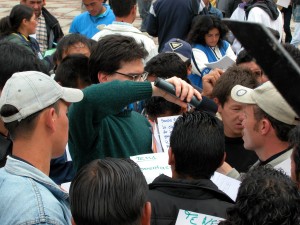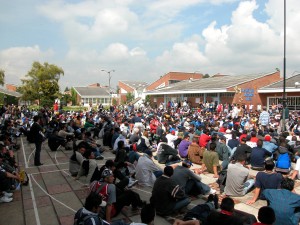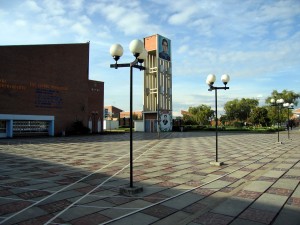This story is written from an Open Space practitioner’s perspective in service to other Open Space practitioners.
Here are the pictures of the event.
Where to begin to tell this story? I hope to channel two of my favorite story tellers, Harrison Owen and Chris Corrigan, who always seem to capture the vibrant aliveness of the event itself.
THE SET-UP
I was already on my way to Bogota, Colombia, to teach a class at Los Andes University on Whole Systems Change. About five weeks before leaving, I received an e-mail from Andrés Agudelo, one of my contacts in Bogota:
> Hi Peggy,
>
> Just a quick note to let you know some good news. I had a meeting with an
> italian priest, Javier de Nicolo who has worked in the
> streets of Bogota helping kids who are abandoned by their families, and get
> into drugs and prostitution (or the guerrilla) to survive. What he has been
> doing is training them in different skills, and he gets them jobs, or makes
> team of youngsters to pave the streets of the city, financed by the mayors
> office and some private funds. He agreed to make an OST in order to motivate
> the kids: they start working with energy, and then fade out.
> What do you think? Would it be interesting for you when you come next
> october?
>
> Best regards,
> Andrés Agudelo
Of course I said yes. The next message, two weeks before the event, added one interesting and challenging wrinkle – this Open Space would be for 2,000 people:
> Hi Peggy,
>
> The priest would like to do an OS for two thousand of the kids/adolescents,
> including three hundred of the people who work with them, if possible oct
> 31st and Nov. 1st. Would this be fine for you?
>
> When would be a good time to talk by phone?
>
> Ciao,
> Andrés
I remember thinking, “2,000 people? Is that for real? I’m sure when we dig into the details, it will be a more ‘normal’ size. And if not, it will be fine (I hope).”
We talked the next day. And sure enough, they wanted 2,000 people present. The context and questions all sounded straightforward enough. I trusted Andrés’ judgment and made the leap. It was a go.
A few days later, 12 days before the event was scheduled was my first conversation with the sponsor; actually the sponsor’s right hand—Helena. As I later learned, Helena is a remarkable dynamo with an extraordinarily competent staff that is used to dealing with very large numbers of kids.
I should mention a couple interesting twists to this story. Since we were in Bogota, the OS would be in Spanish, a language in which I can count to ten and name a few colors. While I had met Andrés during my first trip to Colombia during the summer, this would be our first work together.
During our conference call, I learned that Helena’s exposure to OS consisted of what she had learned through Andrés and one 50-person self-conducted experiment with some of the adults who work with this jobs program. They loved the experience and the results and they were completely committed.
I called both Harrison Owen and Michael Pannwitz to gather any information from their 2,108 person OS that might be useful. They both said essentially the same things:
The dynamics are the same as any other OS….be prepared to be surprised…and have fun.
I arranged to fly in a day early to see the site. Andrés was going to be out of town, so I was on my own in sorting through the logistics. I was still a bit in denial that there might be anything special that I needed to consider for an OS this size.
THE SITE
My first impression was of the sheer beauty of the place. I learned that Fr. Javier de Nicolo was 75 and has been working with street kids for 40 years, helping tens of thousands find a better life. Through the years, he has attracted the resources to build about 8 facilities around the city to house and educate the young people. The site of the OS was primarily for young girls, ages 8-12, many of whom had experienced physical and/or sexual abuse. The plan was to take them off campus when the OS participants, ages 16-22, mostly male, arrived.
My next impression gave me great reason to question my sanity in saying yes. I saw the room planned for the OS. Unlike the US, in Bogota, there’s no handy sign posted with the room capacity. I did a bit of walking and counting and my best estimate was the main floor would hold 750 people sitting on the floor with a tiny circle in the center. The stage could accommodate perhaps another couple hundred and the balcony, with no inside access for posting sessions might hold another couple hundred. Helena seemed completely unfazed by the seeming impossibility of putting 2,000 people in a space that, by her own admission, had never held more than 1,000. That’s when I took the leap and thought to myself, “I’m working with a religious organization. We’re in god’s hands.”
The courtyard leading to the room was big, square and could easily accommodate 2,000. We agreed to prepare both the room and the courtyard and would be outside if the weather made that possible.
Ah, the weather. We were in the rainy season. Bogota is a lush, green place, much like my home town, Seattle. That meant I knew and appreciated the price paid to live in such a beautiful, green place. It rains a lot. I had looked at weather.com and saw nothing but rain in the future.
We talked about tape on the floor to mark aisle ways. We made one accommodation for the limited space inside and windiness outside. Rather than putting the paper and markers on the ground in the center of the circle, lots of volunteers would pass out paper and markers to everyone who wanted them. Conveners would come to the center to announce their issues. That enabled us to keep the center circle small, maximizing sitting space.
They had 40 computers on site and volunteer teachers to support the kids with entering their reports. Plus, they had plans to prepare 2,000 breakfasts and lunches for the two days.
We talked about the theme. The priest had just gotten some devastating news: the jobs they had from public and private sources for the work program were in jeopardy because kids were showing up stoned and were stealing. The theme took on a new urgency and a decidedly fear-based twist: from the best possible job opportunities now and in the future, it became saving the jobs they had. I did my best to open the theme to be more affirmative, future focused. In the end, saving jobs won. The theme:
“Como puedo colaborar YO para que los empleadores nos sigan dando trabajo ahora y en el futuro?”
Loosely translated (I think): How can I contribute to employers not canceling work for us now and in the future?
The oddest part to me is that I never panicked. Rain seemed inevitable and in no way could I picture 2,000 people fitting in the room. The theme was the most fear-based I’d ever work with. And I was calm. Some part of me thought that was very odd. Most of me just knew it would work. Perhaps it was because I was VERY clearly working with people who had handled huge crowds before. While they needed my expertise on the OS logistics, it was clear the kids and I were all in good hands in every other way.
I didn’t actually see Andrés until the day before the event. I had just finished an intense three-day course and he was returning from running an equally consuming multiple day workshop in Ecuador. He saw our OS site for the first time that afternoon. He thought it could hold 1,500, still not the 2,000 we expected. We were both pretty tired. We reviewed a few logistical items that evening but didn’t actually agree to how we would work until the next morning as we drove to the site. And still I was calm. So was Andrés.
For the opening, we took our cue from Harrison and Michael. I’d speak in English, Andrés in Spanish. He wouldn’t do exact translation, rather he’d speak the OS rituals in his own way. We took it a step further—since the number of English speakers was tiny, I would speak one line and he’d add all of the specifics in Spanish. (I actually suggested not appearing at all. Ultimately, we agreed that while they wouldn’t understand my words, there was something important about the presence of this stranger coming from another country to work with them.)
DAY ONE
After gloomy, grey skies and constant rain since I’d arrived, the day, October 31st, dawned with blues skies and sun shine. As far as I was concerned, it was a minor miracle.
We convened in the courtyard, with huge letters put together on the sides of the buildings spelling out the law of two feet, the four principles, the conference theme. It was spectacular. The priest spoke (at length) then turned the microphone over to us. We began.
In recent years, I’ve begun asking for a brief silence anytime the whole group gathers. At a minimum, it is a chance for people to collect their thoughts. More subtlely, there is something very powerful about groups, particularly very large groups sitting together in silence. We were curious how these young people, with their drug-addicted backgrounds and reputation for violence would respond. It was AWESOME! Two thousand young people so quiet you could hear a pin drop.
 We took them through the opening and then it was time to post sessions. And I got my only big surprise. EVERYONE stood up and started milling around. I wasn’t sure what was happening or whether anyone would post anything. And then it began. Andrés was suddenly surrounded by kids with topics on their papers. For the next forty minutes, he stood, rock solid, holding the microphone as one by one, 300+ sessions were announced and posted. So much for our neatly taped aisle ways! The kids entered the hall to look at the agenda wall. And they were on their way.
We took them through the opening and then it was time to post sessions. And I got my only big surprise. EVERYONE stood up and started milling around. I wasn’t sure what was happening or whether anyone would post anything. And then it began. Andrés was suddenly surrounded by kids with topics on their papers. For the next forty minutes, he stood, rock solid, holding the microphone as one by one, 300+ sessions were announced and posted. So much for our neatly taped aisle ways! The kids entered the hall to look at the agenda wall. And they were on their way.
One theme was named over and over: taking responsibility for their actions. The sessions themselves were filled with remarkable conversations:
· Is it time to end the “code of silence” and speak out when someone shows up to work stoned?
· How do we handle people who don’t obey the rules of the program? Should they be kicked out? Helped back into drug rehab?
The kids were deeply engaged. And our challenge was the teachers! They were so used to keeping the kids under control, fearful of violence if they didn’t, that some were taking over moderating groups! Wherever we could, we coached the teachers in real time to participate but not take over. We expressed our distress to Helena and ultimately agreed that we would meet with the teachers in the morning before we opened the space on day 2.
Our concern reached its peak when we heard Helena’s voice over the loud-speaker system that reached the entire campus announcing that it was time to change sessions. And then she kept talking. Andrés went to take the mike from her and returned empty handed. I went out, found her talking to a young man, just holding the mike, and I said, “I’ll take that,” removed it and left. A few minutes later, she joined Andrés and me. We talked to her about how important it was for the young people to experience taking responsibility. She thanked us for the reminder that she was doing exactly what she often told the teachers not to do!
A few minutes later, our blood pressure was raised again. We heard the priest, midday, lecturing over the loud-speaker, telling everyone they should go to work. So much for butterflies! I knew it was my responsibility to keep the space open for the kids. Andrés, as my translator, and I, as someone from completely outside the system, took off to find the priest. I took (respectfully) the microphone out of his hands as he was about to launch into yet another lecture over the loud speaker system. I told him that he was talking to them about responsibility but not giving them the chance to practice it. The process we were using supports people in taking responsibility for what they love, helping them learn to embrace responsibility from within themselves rather than it being imposed by others outside themselves. He told me he wanted what was best for the kids. I said we wanted the same thing. It was a defining moment. He not only took what I said very graciously but the next day, he came with a completely different attitude and no longer a need to lecture at length! I thanked him for his support at lunch on day 2. He said, “Day 1 was the apocalypse. Day 2, we are in heaven.” It is my favorite line from the whole event.
DAY TWO
The clear weather held. We began the day meeting in a circle with the teachers. We asked them how they saw things going. Some were quite distressed, feeling the young people needed better guidance. Others were thrilled with the thoughtfulness and initiative. In the end, we encouraged them to listen as much as possible; to assume that even if what they saw wasn’t the way they’d approach the work, that it was just fine; and if they couldn’t resist intervening, that they do it with a question.
Another 140 sessions went up in the morning and 40 in the afternoon’s action
planning OS. The dynamics were much the same as the day before. No orderly queuing in aisles, just a mob, respectfully waiting their turn to announce their sessions.
The kids were quite amazing. I felt a bit like Mother Therese. Whenever I walked through the square, they surrounded me. Mostly, they wanted to try their 3 or 4 words of English and ask me questions. On the second day, I joined the film crew (yes, we had a professional videographer with us) and started asking the kids questions. They told me that they definitely want to do more OS. When I asked why, one of these hard-core young men (no doubt carrying a knife or a gun somewhere in all that baggy clothing) said it gave him a feeling of family.
One young man approached me right after the space opened to tell me that he had left early on day one but was committed to staying all day today. I wondered if he’d just told me indirectly that he wouldn’t leave to get stoned today.
The man who ran the program was thrilled. He told us that he had learned so much from this. The kids had told him that the program was far too easy on offenders, the rules should be much tougher! His solution: he would ask the kids to define the rules and the consequences. What an incredible shift!
A teacher found me to say that she had gone into a room where the kids were playing cards. Her first impulse was to tell them to get to work. Instead, she remembered the suggestion of asking a question. “Did they need anything?” “No,” they replied, “we’re just fine. We’re taking a break and will get the work done just fine.” The teacher left, a bit bemused, but satisfied that she’d done the right thing.
As you can imagine, there was incredible support from many, many people to pull this off. The kitchen baked 8,000 loaves of bread for day 1. I understand that 2,300 lunches were served that day, making the official count of 1,800 low. (We may have a new OS record! They’re re-counting the number registered.) The team working the computers posted reports as they came in. The last I saw of the report, it was at least 600 pages. None of it would have been possible without my extraordinary colleague in this adventure, Andrés Agudelo. While relatively new to OS, he has many years as a Gestalt therapist and exudes calm even when deluged by several hundred kids surrounding him with sessions to announce.
AFTERWARDS
I left for home the next morning, the weather gray and drizzly, leaving a request for Andrés to let me know what happens. We were quite sure that Pandora’s box was wide open and nothing would be the same.
Four days after the event, Andrés sent this message:
>Hi Peggy,
>
>I will try to call yoou this weekend. A lot of things have happened, but I’d rather talk to you.
>
>Ciao,
>
>Andrés Agudelo
And so it stands….
November 7, 2004



